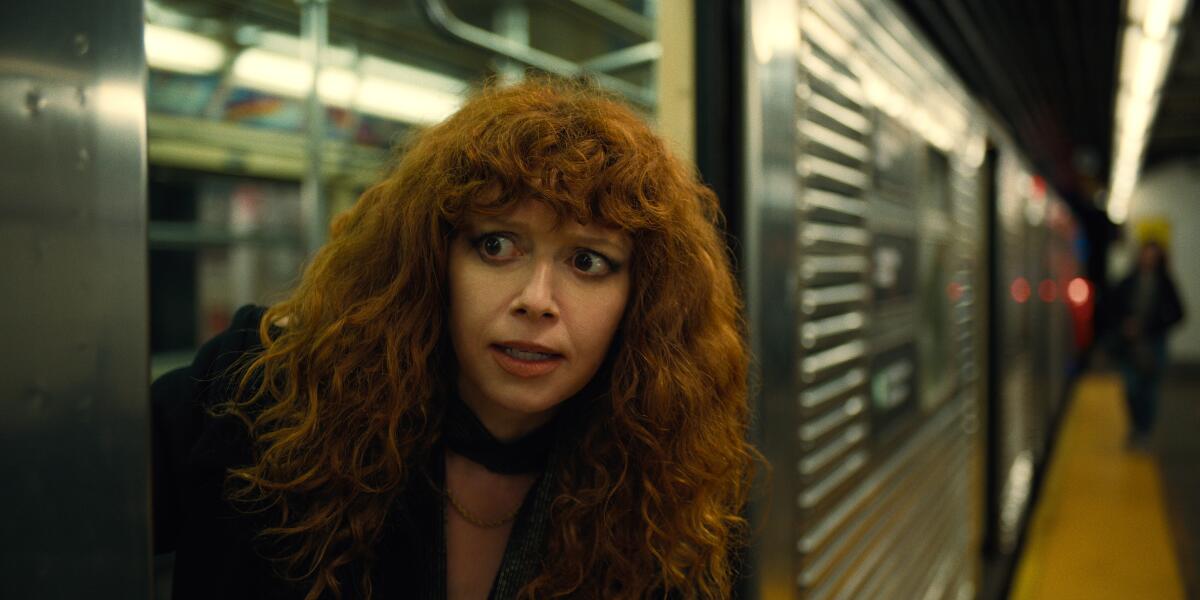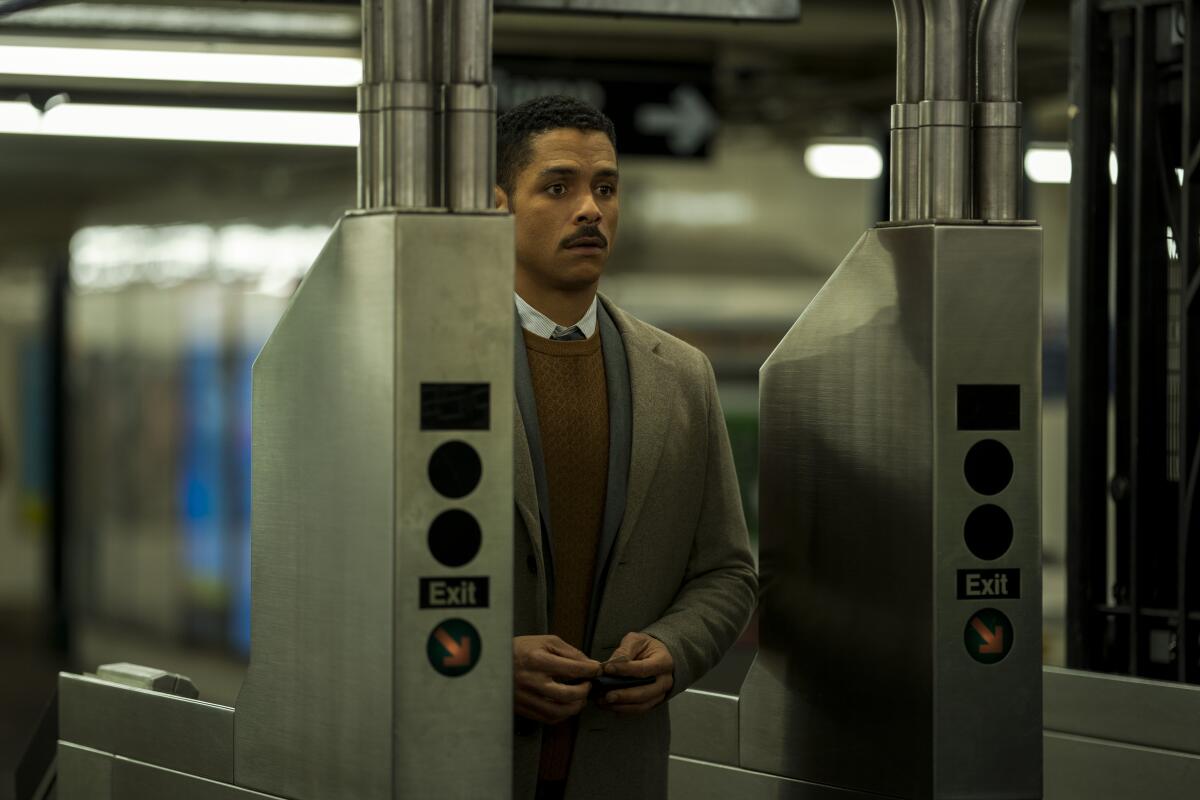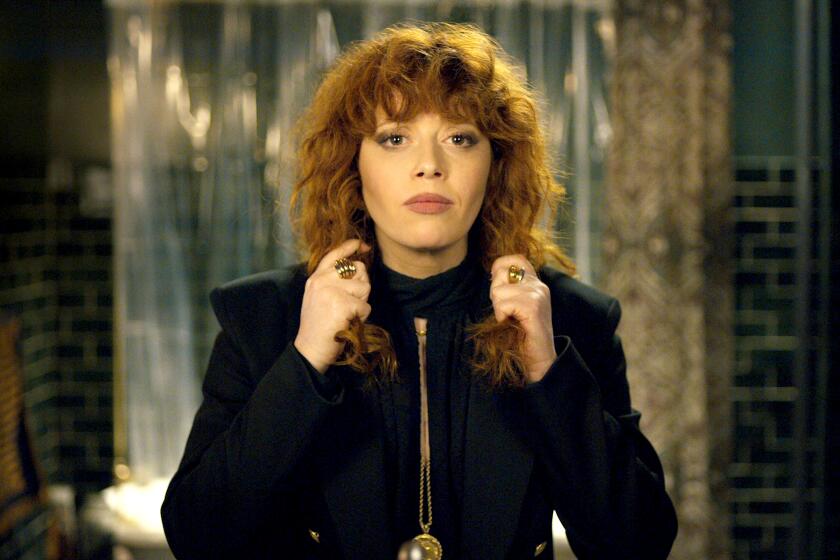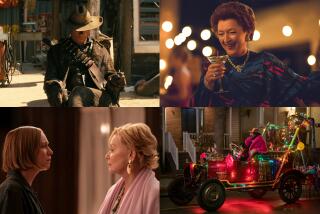‚ÄėRussian Doll‚Äô didn‚Äôt need a second season, but the series pulls it off beautifully

Given how firmly it closed its circular plot, and the relatively peculiar particulars of its narrative ‚ÄĒ ‚Äúrelatively‚ÄĚ since it ran on an engine oft-lifted from ‚ÄúGroundhog Day‚ÄĚ ‚ÄĒ it‚Äôs somewhat surprising to see a second season of ‚ÄúRussian Doll,‚ÄĚ the excellence of its 2019 first season notwithstanding. In that fairy tale of New York, described by Natasha Lyonne‚Äôs main character, Nadia, as ‚Äúthe one about the broken man and the lady with a death wish that got stuck in a loop,‚ÄĚ Nadia and her spookily entangled metaphysical twin, Alan (Charlie Barnett), keep dying until life looks better. It‚Äôs a Borscht Belt SaŠĻÉsńĀra story, with an ending so beautifully landed one wonders what more could possibly be said.
But nothing succeeds a success like a stab at another success, and a second season is here, with Lyonne taking over as showrunner (previous showrunner Leslye Headland and Amy Poehler are her co-creators), and it does the job ably and elegantly. Stylistically and philosophically consistent with its predecessor, it’s different enough to not feel like a calculating retread; as before, it’s admirable in its ingenuity, a little radical and deeply felt in ways that are not radical at all.
We surveyed The Times TV team to come up with a list of the 75 best TV shows you can watch on Netflix. As in, tonight.
Season 2, which begins 10 days shy of Nadia‚Äôs 40th birthday ‚ÄĒ as the first season repeatedly began on the night of her (repeating) 36th ‚ÄĒ moves on by digging in, focusing on a few undeveloped points from Season 1 and fleshing out a backstory. (She has spent the intervening birthdays on DEFCON 1, in case things go weird again.) There is the mental illness of Nadia‚Äôs mother, Nora, played by Chlo√ę Sevigny; the Krugerrand Nadia wears on a chain around her neck, the last remnant of a family legacy and a symbol of loss; and the fact that her grandmother is a Holocaust survivor. (It is all about mothers and grandmothers and children.) These storylines reflect the way the stories we inherit are often incomplete, shaped by the limitations or the intentions of the teller, and the essential business of the new season for Nadia is filling in the gaps.
There are circles in the new season, but they are overlapping circles, arranged in four dimensions and connected by a space-time wormhole in the shape of the New York subway‚Äôs No. 6 train, which will carry Nadia and Alan here and there and then into the lives that made their lives. Like most time-travel tales, it involves trying to change the present by changing the past, but it is not saying too much that what the universe wants to change is the time travelers. (‚ÄúI prefer the term ‚Äėtime prisoner,‚Äô‚ÄĚ says Nadia.) The expanded canvas enlarges the field of investigation ‚ÄĒ as before, this is a sort of detective story ‚ÄĒ which grows geographically as well, to encompass Berlin and Budapest, Hungary. Although the Netflix spoiler police have a bug about reviewers mentioning just what years Nadia and Alan travel to, the official trailer gives you a glimpse of a ‚ÄúSophie‚Äôs Choice‚ÄĚ poster ‚ÄĒ not incidentally, a Holocaust film ‚ÄĒ a man with a mohawk and Nazis. (One perfectly pointless identified spoiler is what character Annie Murphy plays; that will be known soon enough, and the exciting part, anyway, is that Annie Murphy‚Äôs in it.)

Alan’s (less than) half of the story, which involves his Ghanaian grandmother and interesting suggestions gender-wise, can feel a little abbreviated, but its points are made, and he is there in the clutch. Nadia’s godmother, Ruth (Elizabeth Ashley), whose years of smoking may be catching up with her, is very much in the mix, with Greta Lee’s Maxine, liberated from endlessly throwing Nadia’s birthday party, getting more things to do and places to go. (Nadia continues to smoke, drink, take drugs and generally walk a line between fearlessness and recklessness; Alan, by contrast, is cautious to a fault.)
There are many smaller callbacks to the first season, as well ‚ÄĒ Oatmeal the cat, Alan‚Äôs fish, the deli, Horse the homeless guy, Nadia‚Äôs way of pronouncing ‚Äúcockroach‚ÄĚ as ‚Äúcock-a-roach,‚ÄĚ which recalls Zero Mostel‚Äôs reading the opening line of Franz Kafka‚Äôs ‚ÄúMetamorphosis‚ÄĚ in ‚ÄúThe Producers‚ÄĚ ‚ÄĒ and really, you couldn‚Äôt better describe the series‚Äô gestalt than as the mixture of those two works, a little Franz Kafka, a little Mel Brooks. Bathrooms, and bathroom mirrors, and mirrors in general, continue to play a role.
Having already lived through a major disruption of reality, Nadia is hard to rattle ‚ÄĒ ‚ÄúInexplicable things happening is my entire modus operandi,‚ÄĚ she says ‚ÄĒ and as if to match her determination, the new season throws abrupt changes of scene and even weirder dislocations of reality in her way. If uncovered clues and chance meetings feel a little conveniently arranged, they may also be read as the universe giving her what she needs when she needs it, like a bottle labeled ‚ÄúDrink me,‚ÄĚ just when you need to get small enough to fit through that little door. The cosmos may have a strange sense of humor, but it is not unkind. It is also true that the series wastes no time ‚ÄĒ at seven more or less sitcom-length episodes, it is an episode shorter than Season 1 ‚ÄĒ and moves fast. You need coincidence to keep the wheels turning.
Netflix‚Äôs new documentary ‚ÄėWhite Hot: The Rise and Fall of Abercrombie & Fitch‚Äô considers darker side of the onetime mainstay of mall culture.
Armored under a cascade of curls, swathed in a sort of military overcoat that flares dramatically in silhouette, Nadia is a fireplug superhero, if one less concerned with the fate of the world than of her own situation; her selfishness is explicitly noted, with her pursuit of remaking her past getting in the way of her paying attention to the present. She‚Äôs a comedian too ‚ÄĒ every other line of dialogue is a wisecrack ‚ÄĒ a bit like Hamlet, punning his way through tragedy, collaborating with ghosts, with the difference that she tends to plunge ahead instead of dithering. But there is tenderness in her character as well, and anger and love, and Lyonne shades her brilliantly.
Ultimately, it‚Äôs helpful to regard the series, especially in the whipsaw transitions of its beautiful last movements, as musical or poetic. ‚ÄúRussian Doll‚ÄĚ turns somersaults to get where it‚Äôs going, but its conclusions are emotionally unambiguous and universally useful and consonant with the previous season‚Äôs themes of attachment and surrender. The show is smart without ever being too smart for its own good. And if its sentimental streak is leavened with skepticism, sentiment is what makes ‚ÄúRussian Doll‚ÄĚ valuable and skepticism what keeps the sentiment bearable. It‚Äôs the tension between the two effects that makes relief, when it comes, so very powerful.
‚ÄėRussian Doll‚Äô
Where: Netflix
When: Any time, Season 2 available Wednesday
Rating: TV-MA (may be unsuitable for children under age 17)
More to Read
The complete guide to home viewing
Get Screen Gab for everything about the TV shows and streaming movies everyone’s talking about.
You may occasionally receive promotional content from the Los Angeles Times.









